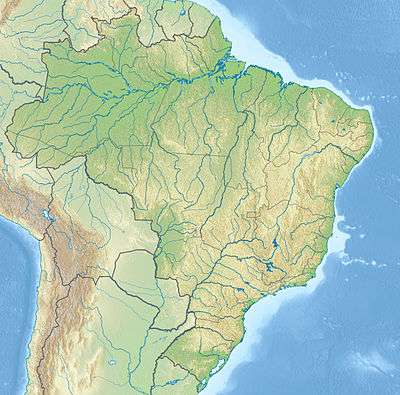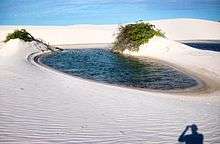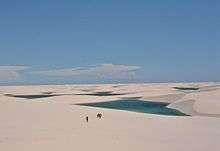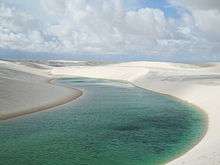Lençóis Maranhenses National Park
| Lençóis Maranhenses National Park | |
|---|---|
|
IUCN category II (national park) | |
|
A lagoon at the National Park | |
 | |
| Location | Northeastern Maranhão, Brazil |
| Coordinates | Coordinates: 02°32′S 43°07′W / 2.533°S 43.117°W |
| Area | 1550 km²[1] |
| Designation | National park |
| Established | 1981 |
| Governing body | IBAMA |
The Lençóis Maranhenses National Park (Parque Nacional dos Lençóis Maranhenses) is a national park located in Maranhão state, in northeastern Brazil, just east of the Baía de São José, between 02º19’—02º45’ S and 42º44’—43º29’ W. It is an area of low, flat, occasionally flooded land, overlaid with large, discrete sand dunes. It encompasses roughly 1,500 km2 (580 sq mi), and despite abundant rain, supports almost no vegetation. The area became a National Park on June 2, 1981.
Description


Composed of large, white, sweeping dunes, at first glance Lençóis Maranhenses looks like an archetypal desert, but in fact it is not an actual one. Lying just outside the Amazon Basin, the region is subject to a regular rain season during the beginning of the year. The rains cause a peculiar phenomenon: fresh water collects in the valleys between sand dunes and is prevented from percolating down by a layer of impermeable rock which lies underneath the sand. The resulting blue, green and black "lagoons" are surrounded by the desert-like sand, and reach their fullest between July and September.
The lagoons have large numbers of fish that arrive when the lagoons are at their fullest after July, when they are interconnected to rivers such as the Rio Negro. One species of fish, the wolf fish or tiger fish (Hoplias malabaricus) stays dormant in the mud and moist areas after the majority of the water has evaporated, re-emerging during the next rainy season.[2]
Inhabitants
According to local folklore, the region was inhabited by Caeté Indians, who woke up one day to find their town covered by sand.
The national park status serves only as a means of protecting the area's ecology; consequently many people reside in the park, as is also the case with nearby Jericoacoara. The inhabitants work primarily as fishermen during the rainy season. During the dry season, many leave for neighboring regions to work small plots of land.
Visiting
Located on the northeastern coast of the state of Maranhão by the banks of the Preguiças River, the park embraces the municipalities of Humberto de Campos, Primeira Cruz, Santo Amaro do Maranhão and Barreirinhas, the latest serving as the main jumping off point into the protected park.
There are several regular bus/truck routes between Barreirinhas and São Luís, Brazil (Maranhão's capital), a distance of about 260 km (160 mi). There are also air taxis from São Luís to Barreirinhas. The Rio Preguiças river connects the park to Atins, a small town at the southern edge of the park. The most important access roads near the park are BR-135, BR-222, MA-404, and MA-225.
The National Park is quite extensive and has no direct access roads. Because of the nature of the park's protected status, most vehicles are not permitted access. Entrance to the park is made exclusively by 4-wheel drive trucks.
In popular culture
The park was featured in the Brazilian film The House of Sand. Kadhal Anukkal, a song from an Indian Tamil language film Enthiran starring Rajnikanth and Aishwarya Rai Bachchan was also shot here.[3][4]
Gallery
 Landscape of the park seen from the dunes
Landscape of the park seen from the dunes Freshwater lagoon
Freshwater lagoon Dunes and lagoons
Dunes and lagoons- Sunset
 Pond
Pond Lagoa dos Peixes (Fish pond)
Lagoa dos Peixes (Fish pond) Fisherman
Fisherman.jpg) The village of Mandacaru, on the outskirts of the park, seen from the lighthouse
The village of Mandacaru, on the outskirts of the park, seen from the lighthouse Dunes
Dunes Lago Verde (Green pond)
Lago Verde (Green pond) Panorama of the park
Panorama of the park- Lagoa Bonita
See also
References
- ↑ "Lençóis Maranhenses Dicas Parque dos Lençóis Maranhenses". Parquelencois.com.br. Retrieved 2015-04-17.
- ↑ "Brazil Dunes - National Geographic Magazine, National Geographic Magazine - NGM.com". Retrieved 2014-05-31.
- ↑ "Kollywood in search of exotic locations". Articles.timesofindia.indiatimes.com. 2010-10-26. Retrieved 2015-04-17.
- ↑ "Lençóis Maranhenses National Park – Brazil". Wherewasitshot.com. 2010-09-28. Retrieved 2015-04-17.
External links
| Wikimedia Commons has media related to Lençóis Maranhenses. |
- Lençóis Maranhenses National Park's Official site
- Photo of Lençóis Maranhenses by Marcio Machado
- Miranda J, Costa J, de Rocha C, Reptiles from Lençóis Maranhenses National Park, Maranhão, northeastern Brazil, Zookeys. 2012; (246): 51–68. Significant study of the fauna of the Lençóis Maranhenses.
